|
|
|


HANS HOLBEIN, the Younger (1497-1543), German painter, favourite son of Hans Holbein the elder, was probably born it Augsburg
about the year 1497. Though Sandrart and Van Mander declare that they do not know who gave him the first lessons, he doubtless received
an artist's education from his father.
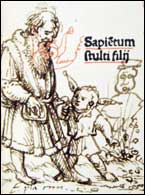 About 1515 he left Augsburg with Ambrose, his elder brother, to seek employment as an illustrator of books at Basel. His first patron
is said to have been Erasmus, for whom, shortly after his arrival, he illustrated with
pen-and-ink sketches
an edition of the Encomium Moriae, now in the museum of Basel. But his chief occupation was that of drawing titlepage-blocks
and initials for new editions of the Bible and classics issued from the presses of Froben and other publishers. His leisure hours,
it is supposed, were devoted to the production of rough painter's work,
a schoolmaster's sign in the Basel collection,
a table with pictures of St Nobody in the library of the university at Zurich.
About 1515 he left Augsburg with Ambrose, his elder brother, to seek employment as an illustrator of books at Basel. His first patron
is said to have been Erasmus, for whom, shortly after his arrival, he illustrated with
pen-and-ink sketches
an edition of the Encomium Moriae, now in the museum of Basel. But his chief occupation was that of drawing titlepage-blocks
and initials for new editions of the Bible and classics issued from the presses of Froben and other publishers. His leisure hours,
it is supposed, were devoted to the production of rough painter's work,
a schoolmaster's sign in the Basel collection,
a table with pictures of St Nobody in the library of the university at Zurich.
In contrast with these coarse productions, the portraits of Jacob Meyer
and his wife in the Basel museum, one of which
purports to have been finished in 1516, are miracles of workmanship. It has always seemed difficult indeed to ascribe such excellent
creations to Holbein's nineteenth year; and it is hardly credible that he should have been asked to do things of this kind so early,
especially when it is remembered that neither he nor his brother Ambrose were then allowed to matriculate in the guild of Basel. Not
till 1517 did Ambrose, whose life otherwise remains obscure, join that corporation; Hans, not overburdened with practice, wandered
into Switzerland, where (1517) he was employed to paint in the house of Jacob Hertenstein at Lucerne.
In 1519 Holbein reappeared at Basel, where he matriculated and, there is every reason to think, married. Whether, previous to this time,
he took advantage of his vicinity to the Italian border to cross the Alps is uncertain. Van Mander says that he never was in Italy;
yet the large wall-paintings which he executed after 1519 at Basel, and the series of his sketches and pictures which is still extant,
might lead to the belief that Van Mander was misinformed. The spirit of Holbein's compositions for the Basel town hall, the scenery
and architecture of his numerous drawings, and the cast of form in some of his imaginative portraits, make it more likely that he
should have felt the direct influence of North Italian painting than that he should have taken Italian element from imported works
or prints. The Swiss at this period wandered in thousands to swell the ranks of the French or imperial armies fighting on Italian soil,
and the road they took may have been followed by Hans on a more peaceful mission.
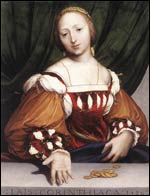 He shows himself at all events familiar with Italian exampla at various periods of his career; and if we accept as early works the
"Flagellation,"
and the "Last Supper"
at Basel, coarse as they are, they show some acquaintance with Lombard methods of painting, whilst in other pieces, such as the
series of the Passion in oil in the same collection, the modes of Hans Holbein the elder are agreeably commingled with a more modern,
it may be said Italian, polish. Again, looking at the
"Virgin"
and "Man of Sorrows" in the Basel museum, we
shall be struck by a searching metallic style akin to that of the Ferrarese; and the "Lais"
or the "Venus and Amor" of the same collection
reminds us of the Leonardesques of the school of Milan.
He shows himself at all events familiar with Italian exampla at various periods of his career; and if we accept as early works the
"Flagellation,"
and the "Last Supper"
at Basel, coarse as they are, they show some acquaintance with Lombard methods of painting, whilst in other pieces, such as the
series of the Passion in oil in the same collection, the modes of Hans Holbein the elder are agreeably commingled with a more modern,
it may be said Italian, polish. Again, looking at the
"Virgin"
and "Man of Sorrows" in the Basel museum, we
shall be struck by a searching metallic style akin to that of the Ferrarese; and the "Lais"
or the "Venus and Amor" of the same collection
reminds us of the Leonardesques of the school of Milan.
When Holbein settled down to an extensive practice at Basel in 1519, he decorated the walls of the
house "Zum Tanz" with simulated architectural features
of a florid character after the fashion of the Veronese; and his wall paintings in the town-hall, if we can truly judge of them by
copies, reveal an artist not unfamiliar with North Italian composition, distribution, action, gesture and expression. In his drawings
too, particularly in a set representing the Passion
at Basel, the arrangement, and also the perspective, form and decorative ornament, are in the spirit of the school of Mantegna. Contemporary
with these, however, and almost inexplicably in contrast with them as regards handling, are portrait-drawings such as the
likenesses of Jacob Meyer, and his wife,
which are finished with German delicacy, and with a power and subtlety of hand seldom rivalled in any school.
Curiously enough, the same contrast may be observed between painted compositions and painted portraits. The
"Bonifacius Amerbach" of 1519 at Basel is acknowledged
to be one of the most complete examples of smooth and transparent handling that Holbein ever executed. His versatility at this period is
shown by a dead Christ (1521), a corpse in profile
on a dissecting table, and a set of figures in couples; the "Madonna and St Pantalus,"
and "Kaiser Henry with the Empress Kunigunde" (1522),
originally composed for the organ loft of the Basel cathedral, now in the Basel museum.
Equally remarkable, but more attractive, though injured, is the "Virgin and Child between St Ursus and St Nicholas"
(not St Martin) giving alms to a beggar, in the gallery of Solothurn. This remarkable picture is dated 1527, and seems to have been ordered
for an altar in the minster of St Ursus of Solothurn by Nicholas Conrad, a captain and statesman of the 16th century, whose family allowed
the precious heirloom to fall into decay in a chapel of the neighbouring village of Grenchen. Numerous drawings in the spirit of this picture,
and probably of the same period in his career, might have led Holbein's contemporaries to believe that he would make his mark in the annals of
Basel as a model for painters of altarpieces as well as a model for pictorial composition and portrait.
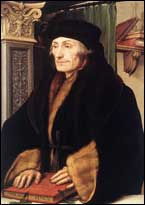 The promise which he gave at this time was immense. He was gaining a freedom in draughtsmanship that gave him facility to deal with any subject.
Though a realist, he was sensible of the dignity and severity of religious painting. His colour had almost all the richness and sweetness of
the Venetians. But he had fallen on evil times, as the next few years undoubtedly showed. Amongst the portraits which he executed in these
years are those of Froben, the publisher,
known only by copies at Basel and Hampton Court, and Erasmus, who sat in 1523, as he likewise did in 1530, in various positions, showing his face
threequarters as at 1) Longford,
2) Basel, 3) Turin,
4) Parma, 5) the Hague and 6) Vienna, and in profile
as in the 7) Louvre or at
8) Hampton Court.
The promise which he gave at this time was immense. He was gaining a freedom in draughtsmanship that gave him facility to deal with any subject.
Though a realist, he was sensible of the dignity and severity of religious painting. His colour had almost all the richness and sweetness of
the Venetians. But he had fallen on evil times, as the next few years undoubtedly showed. Amongst the portraits which he executed in these
years are those of Froben, the publisher,
known only by copies at Basel and Hampton Court, and Erasmus, who sat in 1523, as he likewise did in 1530, in various positions, showing his face
threequarters as at 1) Longford,
2) Basel, 3) Turin,
4) Parma, 5) the Hague and 6) Vienna, and in profile
as in the 7) Louvre or at
8) Hampton Court.
Besides these, Holbein made designs for glass windows, and for woodcuts, including subjects of every sort, from the Virgin and Child with saints
of the old time to the Dance of Death, from gospel incidents
extracted from Luther's Bible to satirical pieces illustrating the sale of indulgences and other abuses denounced by Reformers. Holbein, in this
way, was carried irresistibly with the stream of the Reformation, in which, it must now be admitted, the old traditions of religious painting
were wrecked, leaving nothing behind but unpictorial elements which Cranach and his school vainly used for pictorial purposes.
Once only, after 1526, and after he had produced the "Lais"
and "Venus and Amor," did Holbein with impartial spirit give
his services and pencil to the Roman Catholic cause. The burgomaster Meyer, whose patronage he had already enjoyed, now asked him to represent
himself and his wives and children in prayer before the Virgin; and Holbein produced the celebrated altarpiece
now in the palace... at Darmstadt, the shape and composition of which are known to all the world by its copy in the Dresden museum. The drawings
for this masterpiece are amongst the most precious relics in the museum of Basel.
The time now came when art began to suffer from unavoidable depression in all countries north of the Alps. Holbein, at Basel, was reduced to accept
the smallest commissions — even for scutcheons. Then he saw that his chances were dwindling to nothing, and taking a bold resolution, armed
with letters of introduction from Erasmus to More, he crossed
the Channel to England, where in the one-sided branch of portrait painting he found an endless circle of clients. Eighty-seven drawings by Holbein
in Windsor Castle, containing an equal number of portraits, of persons chiefly of high quality, testify to his industry in the years which divide
1528 from 1543. They are all originals of pictures that are still extant, or sketches for pictures that were lost or never carried out.
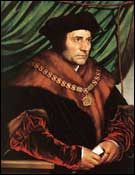 Sir Thomas More, with whom he seems to have had a very friendly connexion, sat to him for
likenesses of various kinds. The drawing of his head
is at Windsor. A pen-and-ink sketch, in which we see
More surrounded by all the members of his family,
is now in the gallery of Basel, and numerous copies of a picture from it prove how popular the lost original must once have been.
Sir Thomas More, with whom he seems to have had a very friendly connexion, sat to him for
likenesses of various kinds. The drawing of his head
is at Windsor. A pen-and-ink sketch, in which we see
More surrounded by all the members of his family,
is now in the gallery of Basel, and numerous copies of a picture from it prove how popular the lost original must once have been.
At the same period were executed the portraits of Warham (1. Lambeth
and 2. Louvre), [Sir Henry] Wyatt
(Louvre), Sir Henry Guildford
and his wife (Windsor), all finished in 1527, the astronomer Nicholas Kratzer
(Louvre), Thomas Godsalve (Dresden), and
Sir Bryan Tuke ([Washington and] Munich) in 1528. In this year,
1528, Holbein returned to Basel, taking to Erasmus the sketch of More's family. With money which he brought from London he purchased a house at
Basel wherein to lodge his wife and children, whose portraits
he now painted with all the care of a husband and father (1528).
He then witnessed the flight of Erasmus and the fury of the iconoclasts, who destroyed in one day almost all the religious pictures at Basel. The
municipality, unwilling that he should suffer again from the depression caused by evil times, asked him to finish the frescoes of the town-hall,
and the sketches from these lost pictures are still before us to show that he had not lost the spirit of his earlier days, and was still capable
as a composer. His "Rehoboam receiving the Israelite Envoys,"
and "Saul at the Head of his Array meeting Samuel,"
testify to Holbein's power and his will, also proved at a later period by the "Triumphs of Riches and Poverty,"
executed for the Steelyard in London (but now lost), to prefer the fame of a painter of history to that of a painter of portraits.
But the reforming times still remained unfavourable to art. With the exception of a
portrait of Melanchthon
(Hanover) which he now completed, Holbein found little to do at Basel. The year 1530, therefore, saw him again on the move, and he landed in
England for the second time with the prospect of bettering his fortunes. Here indeed political changes had robbed him of his earlier patrons.
The circle of More and Warham was gone. But that of the merchants of the Steelyard took its place, for whom Holbein executed the long and
important scries of portraits that lie scattered throughout the galleries and collections of England and the Continent, and bear date after 1532.
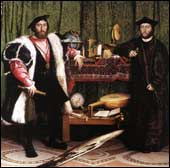 Then came again the chance of practice in more fashionable circles. In 1333 the "Ambassadors"
(National Gallery), and the "Triumphs of Wealth and Poverty" were executed, then the portraits of Leland and
Wyatt (Longford)
, and (1534) the portrait of Thomas Cromwell. Through
Cromwell Holbein probably became attached to the court, in the pay of which he appears permanently after 1537. From that
time onwards he was connected with all that was highest in the society of London. Henry VIII
invited him to make a family picture of himself, his father and family, which obtained
a post of honour at Whitehall. The beautiful cartoon of a part of this fine piece...
enables us to gauge its beauty before the fire which destroyed it in the 17th century.
Then came again the chance of practice in more fashionable circles. In 1333 the "Ambassadors"
(National Gallery), and the "Triumphs of Wealth and Poverty" were executed, then the portraits of Leland and
Wyatt (Longford)
, and (1534) the portrait of Thomas Cromwell. Through
Cromwell Holbein probably became attached to the court, in the pay of which he appears permanently after 1537. From that
time onwards he was connected with all that was highest in the society of London. Henry VIII
invited him to make a family picture of himself, his father and family, which obtained
a post of honour at Whitehall. The beautiful cartoon of a part of this fine piece...
enables us to gauge its beauty before the fire which destroyed it in the 17th century.
Then Holbein painted Jane Seymour in state (Vienna), employing
some English band perhaps to make the replicas at 1. the Hague,
Sion House and Woburn; he finished the [Sir Richard] Southwell of
the Uffizi, the jeweller Morett at Dresden, and last, not least,
Christine of Denmark, who gave sittings at Brussels in 1538.
During the journey which this work involved Holbein took the opportunity of revisiting Basel, where he made his appearance in silk and satin, and pro
forma only accepted the office of town painter. He had been living long and continuously away from home, not indeed observing due fidelity to his wife,
who still resided at Basel, but fairly performing the duties of keeping her in comfort.
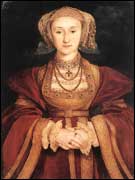 His return to London in autumn enabled him to do homage to the king in the way familiar to artists. He presented to Henry at Christmas a
portrait of Prince Edward. Again abroad in the summer of 1539,
he painted with great fidelity the princess Anne of Cleves, at Düren near
Cologne, whose form we still see depicted in the great picture of the Louvre. That he could render the features of his sitter without flattery is plain
from this one example. Indeed, habitual flattery was contrary to his habits.
His return to London in autumn enabled him to do homage to the king in the way familiar to artists. He presented to Henry at Christmas a
portrait of Prince Edward. Again abroad in the summer of 1539,
he painted with great fidelity the princess Anne of Cleves, at Düren near
Cologne, whose form we still see depicted in the great picture of the Louvre. That he could render the features of his sitter without flattery is plain
from this one example. Indeed, habitual flattery was contrary to his habits.
His portraits up to this time all display that uncommon facility for seizing character which his father enjoyed before him, and which he had inherited
in an expanded form. No amount of labour, no laboriousness of finish — and of both he was ever prodigal — betrayed him into loss of resemblance
or expression. No painter was ever quicker at noting peculiarities of physiognomy, and it may be observed that in none of his faces, as indeed in none
of the faces one sees in nature, are the two sides alike. Yet he was not a child of the 16th century, as the Venetians were, in substituting touch for
line. We must not look in his works for modulations of surface or subtle contrasts of colour in juxtaposition. His method was to the very last delicate,
finished and smooth, as became a painter of the old school.
Amongst the more important creations of Holbein's later time we should note his "Duke of Norfolk"
at Windsor, the hands of which are so perfectly preserved as to compensate for the shrivel that now disfigures the head. Two other portraits of 1541
([De Vos van Steenwijk in] Berlin and
[Unknown Young Man in] Vienna), the
Falconer at the Hague, and
John Chambers at Vienna (1542), are noble specimens of portrait art;
most interesting and of the same year are the likenesses of Holbein himself, of which several examples are extant — one particularly good at Fähna,
the seat of the Stackelberg family near Riga, and another at the Uffizi
in Florence. Here Holbein appears to us as a man of regular features, with hair just turning grey, but healthy in colour and shape, and evidently well to
do in the world.
Yet a few months only separated him then from his death-bed. He was busy painting a picture of
Henry the VIII confirming the Privileges of the Barber Surgeons
(Lincoln's Inn Fields), when he sickened of the plague and died after making a will about November 1543. His loss must have been seriously felt in England.
Had he lived his last years in Germany, he would not have changed the current which decided the fate of painting in that country; he would but have shared
the fate of Dührer and others who merely prolonged the agony of art amidst the troubles of the Reformation.
Source:
Crowe, Sir Joseph Archer. "Hans Holbein the Younger."
The Encyclopædia Britannica. 11th Ed. Vol. XIII.
New York: The Encyclopædia Britannica Co., 1910. 578-580.
Web Links:
 | to Luminarium Encyclopedia |
Site ©1996-2023 Anniina Jokinen. All rights reserved.
This page was created on August 21, 2009. Last updated February 21, 2023.
|
Index of Encyclopedia Entries:
Medieval Cosmology
Prices of Items in Medieval England
Edward II
Isabella of France, Queen of England
Piers Gaveston
Thomas of Brotherton, E. of Norfolk
Edmund of Woodstock, E. of Kent
Thomas, Earl of Lancaster
Henry of Lancaster, Earl of Lancaster
Henry of Grosmont, Duke of Lancaster
Roger Mortimer, Earl of March
Hugh le Despenser the Younger
Bartholomew, Lord Burghersh, elder
Hundred Years' War (1337-1453)
Edward III
Philippa of Hainault, Queen of England
Edward, Black Prince of Wales
John of Eltham, Earl of Cornwall
The Battle of Crécy, 1346
The Siege of Calais, 1346-7
The Battle of Poitiers, 1356
Lionel of Antwerp, Duke of Clarence
John of Gaunt, Duke of Lancaster
Edmund of Langley, Duke of York
Thomas of Woodstock, Gloucester
Richard of York, E. of Cambridge
Richard Fitzalan, 3. Earl of Arundel
Roger Mortimer, 2nd Earl of March
The Good Parliament, 1376
Richard II
The Peasants' Revolt, 1381
Lords Appellant, 1388
Richard Fitzalan, 4. Earl of Arundel
Archbishop Thomas Arundel
Thomas de Beauchamp, E. Warwick
Robert de Vere, Earl of Oxford
Ralph Neville, E. of Westmorland
Thomas Mowbray, Duke of Norfolk
Edmund Mortimer, 3. Earl of March
Roger Mortimer, 4. Earl of March
John Holland, Duke of Exeter
Michael de la Pole, E. Suffolk
Hugh de Stafford, 2. E. Stafford
Henry IV
Edward, Duke of York
Edmund Mortimer, 5. Earl of March
Henry Percy, Earl of Northumberland
Sir Henry Percy, "Harry Hotspur"
Thomas Percy, Earl of Worcester
Owen Glendower
The Battle of Shrewsbury, 1403
Archbishop Richard Scrope
Thomas Mowbray, 3. E. Nottingham
John Mowbray, 2. Duke of Norfolk
Thomas Fitzalan, 5. Earl of Arundel
Henry V
Thomas, Duke of Clarence
John, Duke of Bedford
Humphrey, Duke of Gloucester
John Talbot, Earl of Shrewsbury
Richard, Earl of Cambridge
Henry, Baron Scrope of Masham
William de la Pole, Duke of Suffolk
Thomas Montacute, E. Salisbury
Richard Beauchamp, E. of Warwick
Henry Beauchamp, Duke of Warwick
Thomas Beaufort, Duke of Exeter
Cardinal Henry Beaufort
John Beaufort, Earl of Somerset
Sir John Fastolf
John Holland, 2. Duke of Exeter
Archbishop John Stafford
Archbishop John Kemp
Catherine of Valois
Owen Tudor
John Fitzalan, 7. Earl of Arundel
John, Lord Tiptoft
Charles VII, King of France
Joan of Arc
Louis XI, King of France
Charles the Bold, Duke of Burgundy
The Battle of Agincourt, 1415
The Battle of Castillon, 1453
The Wars of the Roses 1455-1485
Causes of the Wars of the Roses
The House of Lancaster
The House of York
The House of Beaufort
The House of Neville
The First Battle of St. Albans, 1455
The Battle of Blore Heath, 1459
The Rout of Ludford, 1459
The Battle of Northampton, 1460
The Battle of Wakefield, 1460
The Battle of Mortimer's Cross, 1461
The 2nd Battle of St. Albans, 1461
The Battle of Towton, 1461
The Battle of Hedgeley Moor, 1464
The Battle of Hexham, 1464
The Battle of Edgecote, 1469
The Battle of Losecoat Field, 1470
The Battle of Barnet, 1471
The Battle of Tewkesbury, 1471
The Treaty of Pecquigny, 1475
The Battle of Bosworth Field, 1485
The Battle of Stoke Field, 1487
Henry VI
Margaret of Anjou
Richard Plantagenet, Duke of York
Edward IV
Elizabeth Woodville
Richard Woodville, 1. Earl Rivers
Anthony Woodville, 2. Earl Rivers
Jane Shore
Edward V
Richard III
George, Duke of Clarence
Ralph Neville, 2. Earl of Westmorland
Richard Neville, Earl of Salisbury
Richard Neville, Earl of Warwick
Edward Neville, Baron Bergavenny
William Neville, Lord Fauconberg
Robert Neville, Bishop of Salisbury
John Neville, Marquis of Montagu
George Neville, Archbishop of York
John Beaufort, 1. Duke Somerset
Edmund Beaufort, 2. Duke Somerset
Henry Beaufort, 3. Duke of Somerset
Edmund Beaufort, 4. Duke Somerset
Margaret Beaufort
Edmund Tudor, Earl of Richmond
Jasper Tudor, Earl of Pembroke
Humphrey Stafford, D. Buckingham
Henry Stafford, Duke of Buckingham
Humphrey Stafford, E. of Devon
Thomas, Lord Stanley, Earl of Derby
Sir William Stanley
Archbishop Thomas Bourchier
Henry Bourchier, Earl of Essex
John Mowbray, 3. Duke of Norfolk
John Mowbray, 4. Duke of Norfolk
John Howard, Duke of Norfolk
Henry Percy, 2. E. Northumberland
Henry Percy, 3. E. Northumberland
Henry Percy, 4. E. Northumberland
William, Lord Hastings
Henry Holland, Duke of Exeter
William Fitzalan, Earl of Arundel
William Herbert, 1. Earl of Pembroke
John de Vere, 12th Earl of Oxford
John de Vere, 13th Earl of Oxford
Thomas de Clifford, 8. Baron Clifford
John de Clifford, 9. Baron Clifford
John Tiptoft, Earl of Worcester
Thomas Grey, 1. Marquis Dorset
Sir Andrew Trollop
Archbishop John Morton
Edward Plantagenet, E. of Warwick
John Talbot, 2. E. Shrewsbury
John Talbot, 3. E. Shrewsbury
John de la Pole, 2. Duke of Suffolk
John de la Pole, E. of Lincoln
Edmund de la Pole, E. of Suffolk
Richard de la Pole
John Sutton, Baron Dudley
James Butler, 5. Earl of Ormonde
Sir James Tyrell
Edmund Grey, first Earl of Kent
George Grey, 2nd Earl of Kent
John, 5th Baron Scrope of Bolton
James Touchet, 7th Baron Audley
Walter Blount, Lord Mountjoy
Robert Hungerford, Lord Moleyns
Thomas, Lord Scales
John, Lord Lovel and Holand
Francis Lovell, Viscount Lovell
Sir Richard Ratcliffe
William Catesby
Ralph, 4th Lord Cromwell
Jack Cade's Rebellion, 1450
Tudor Period
King Henry VII
Queen Elizabeth of York
Arthur, Prince of Wales
Lambert Simnel
Perkin Warbeck
The Battle of Blackheath, 1497
King Ferdinand II of Aragon
Queen Isabella of Castile
Maximilian I, Holy Roman Emperor
King Henry VIII
Queen Catherine of Aragon
Queen Anne Boleyn
Queen Jane Seymour
Queen Anne of Cleves
Queen Catherine Howard
Queen Katherine Parr
King Edward VI
Queen Mary I
Queen Elizabeth I
Henry Fitzroy, Duke of Richmond
Margaret Tudor, Queen of Scotland
James IV, King of Scotland
The Battle of Flodden Field, 1513
James V, King of Scotland
Mary of Guise, Queen of Scotland
Mary Tudor, Queen of France
Louis XII, King of France
Francis I, King of France
The Battle of the Spurs, 1513
Field of the Cloth of Gold, 1520
Charles V, Holy Roman Emperor
Eustace Chapuys, Imperial Ambassador
The Siege of Boulogne, 1544
Cardinal Thomas Wolsey
Archbishop Thomas Cranmer
Thomas Cromwell, Earl of Essex
Thomas, Lord Audley
Thomas Wriothesley, E. Southampton
Sir Richard Rich
Edward Stafford, D. of Buckingham
Thomas Howard, 2nd Duke of Norfolk
Thomas Howard, 3rd Duke of Norfolk
John Dudley, Duke of Northumberland
Charles Brandon, Duke of Suffolk
Thomas Boleyn, Earl of Wiltshire
George Boleyn, Viscount Rochford
John Russell, Earl of Bedford
Thomas Grey, 2. Marquis of Dorset
Henry Grey, D. of Suffolk
Charles Somerset, Earl of Worcester
George Talbot, 4. E. Shrewsbury
Francis Talbot, 5. E. Shrewsbury
Henry Algernon Percy,
5th Earl of Northumberland
Henry Algernon Percy,
6th Earl of Northumberland
Ralph Neville, 4. E. Westmorland
Henry Neville, 5. E. Westmorland
William Paulet, Marquis of Winchester
Sir Francis Bryan
Sir Nicholas Carew
John de Vere, 15th Earl of Oxford
John de Vere, 16th Earl of Oxford
Thomas Seymour, Lord Admiral
Edward Seymour, Protector Somerset
Margaret Pole, Countess of Salisbury
Henry Pole, Lord Montague
Sir Geoffrey Pole
Thomas Manners, Earl of Rutland
Henry Manners, Earl of Rutland
Henry Bourchier, 2. Earl of Essex
Robert Radcliffe, 1. Earl of Sussex
Henry Radcliffe, 2. Earl of Sussex
George Hastings, Earl of Huntingdon
Henry Courtenay, Marquis of Exeter
George Neville, Baron Bergavenny
Sir Edward Neville
William, Lord Paget
William Sandys, Baron Sandys
William Fitzwilliam, E. Southampton
Sir Anthony Browne
Sir Thomas Wriothesley
Sir William Kingston
George Brooke, Lord Cobham
Sir Richard Southwell
Thomas Fiennes, 9th Lord Dacre
Sir Francis Weston
Henry Norris
Lady Jane Grey
Sir Thomas Arundel
Sir Richard Sackville
Sir William Petre
Sir John Cheke
Walter Haddon, L.L.D
Sir Peter Carew
Sir John Mason
Nicholas Wotton
John Taylor
Sir Thomas Wyatt, the Younger
Cardinal Lorenzo Campeggio
Cardinal Reginald Pole
Stephen Gardiner, Bishop of Winchester
Edmund Bonner, Bishop of London
Nicholas Ridley, Bishop of London
John Hooper, Bishop of Gloucester
John Aylmer, Bishop of London
Thomas Linacre
William Grocyn
Archbishop William Warham
Cuthbert Tunstall, Bishop of Durham
Richard Fox, Bishop of Winchester
Edward Fox, Bishop of Hereford
Pope Julius II
Pope Leo X
Pope Clement VII
Pope Paul III
Pope Pius V
Pico della Mirandola
Desiderius Erasmus
Martin Bucer
Richard Pace
Christopher Saint-German
Thomas Tallis
Elizabeth Barton, the Nun of Kent
Hans Holbein, the Younger
The Sweating Sickness
Dissolution of the Monasteries
Pilgrimage of Grace, 1536
Robert Aske
Anne Askew
Lord Thomas Darcy
Sir Robert Constable
Oath of Supremacy
The Act of Supremacy, 1534
The First Act of Succession, 1534
The Third Act of Succession, 1544
The Ten Articles, 1536
The Six Articles, 1539
The Second Statute of Repeal, 1555
The Act of Supremacy, 1559
Articles Touching Preachers, 1583
Queen Elizabeth I
William Cecil, Lord Burghley
Robert Cecil, 1st Earl of Salisbury
Sir Francis Walsingham
Sir Nicholas Bacon
Sir Thomas Bromley
Robert Dudley, Earl of Leicester
Ambrose Dudley, Earl of Warwick
Henry Carey, Lord Hunsdon
Sir Thomas Egerton, Viscount Brackley
Sir Francis Knollys
Katherine "Kat" Ashley
Lettice Knollys, Countess of Leicester
George Talbot, 6. E. of Shrewsbury
Elizabeth, Countess of Shrewsbury
Gilbert Talbot, 7. E. of Shrewsbury
Sir Henry Sidney
Sir Robert Sidney
Archbishop Matthew Parker
Walter Devereux, 1st Earl of Essex
Robert Devereux, 2nd Earl of Essex
Penelope Devereux, Lady Rich
Sir Christopher Hatton
Edward Courtenay, E. Devonshire
Edward Manners, 3rd Earl of Rutland
Thomas Radcliffe, 3. Earl of Sussex
Henry Radcliffe, 4. Earl of Sussex
Robert Radcliffe, 5. Earl of Sussex
William Parr, Marquis of Northampton
Henry Wriothesley, 2. Southampton
Henry Wriothesley, 3. Southampton
Charles Neville, 6. E. Westmorland
Thomas Percy, 7. E. Northumberland
Henry Percy, 8. E. Northumberland
Henry Percy, 9. E. Nothumberland
William Herbert, 1. Earl of Pembroke
Charles, Lord Howard of Effingham
Thomas Howard, 4th Duke of Norfolk
Henry Howard, 1. Earl of Northampton
Thomas Howard, 1. Earl of Suffolk
Henry Hastings, 3. E. of Huntingdon
Edward Manners, 3rd Earl of Rutland
Roger Manners, 5th Earl of Rutland
Francis Manners, 6th Earl of Rutland
Henry FitzAlan, 12. Earl of Arundel
Thomas, Earl Arundell of Wardour
Edward Somerset, E. of Worcester
William Davison
Sir Walter Mildmay
Sir Ralph Sadler
Sir Amyas Paulet
Gilbert Gifford
Anthony Browne, Viscount Montague
François, Duke of Alençon & Anjou
Mary, Queen of Scots
Henry Stuart, Lord Darnley
James Hepburn, Earl of Bothwell
Anthony Babington and the Babington Plot
John Knox
Philip II of Spain
The Spanish Armada, 1588
Sir Francis Drake
Sir John Hawkins
William Camden
Archbishop Whitgift
Martin Marprelate Controversy
John Penry (Martin Marprelate)
Richard Bancroft, Archbishop of Canterbury
John Dee, Alchemist
Philip Henslowe
Edward Alleyn
The Blackfriars Theatre
The Fortune Theatre
The Rose Theatre
The Swan Theatre
Children's Companies
The Admiral's Men
The Lord Chamberlain's Men
Citizen Comedy
The Isle of Dogs, 1597
Common Law
Court of Common Pleas
Court of King's Bench
Court of Star Chamber
Council of the North
Fleet Prison
Assize
Attainder
First Fruits & Tenths
Livery and Maintenance
Oyer and terminer
Praemunire
The Stuarts
King James I of England
Anne of Denmark
Henry, Prince of Wales
The Gunpowder Plot, 1605
George Villiers, 1st Duke of Buckingham
Robert Carr, Earl of Somerset
Arabella Stuart, Lady Lennox
William Alabaster
Bishop Hall
Bishop Thomas Morton
Archbishop William Laud
John Selden
Lucy Harington, Countess of Bedford
Henry Lawes
King Charles I
Queen Henrietta Maria
Long Parliament
Rump Parliament
Kentish Petition, 1642
Thomas Wentworth, Earl of Strafford
John Digby, Earl of Bristol
George Digby, 2nd Earl of Bristol
Thomas Fairfax, 3rd Lord Fairfax
Robert Devereux, 3rd E. of Essex
Robert Sidney, 2. E. of Leicester
Algernon Percy, E. of Northumberland
Henry Montagu, Earl of Manchester
Edward Montagu, 2. Earl of Manchester
The Restoration
King Charles II
King James II
Test Acts
Greenwich Palace
Hatfield House
Richmond Palace
Windsor Palace
Woodstock Manor
The Cinque Ports
Mermaid Tavern
Malmsey Wine
Great Fire of London, 1666
Merchant Taylors' School
Westminster School
The Sanctuary at Westminster
"Sanctuary"
Images:
Chart of the English Succession from William I through Henry VII
Medieval English Drama
London c1480, MS Royal 16
London, 1510, the earliest view in print
Map of England from Saxton's Descriptio Angliae, 1579
London in late 16th century
Location Map of Elizabethan London
Plan of the Bankside, Southwark, in Shakespeare's time
Detail of Norden's Map of the Bankside, 1593
Bull and Bear Baiting Rings from the Agas Map (1569-1590, pub. 1631)
Sketch of the Swan Theatre, c. 1596
Westminster in the Seventeenth Century, by Hollar
Visscher's View of London, 1616
Larger Visscher's View in Sections
c. 1690. View of London Churches, after the Great Fire
The Yard of the Tabard Inn from Thornbury, Old and New London
|
|